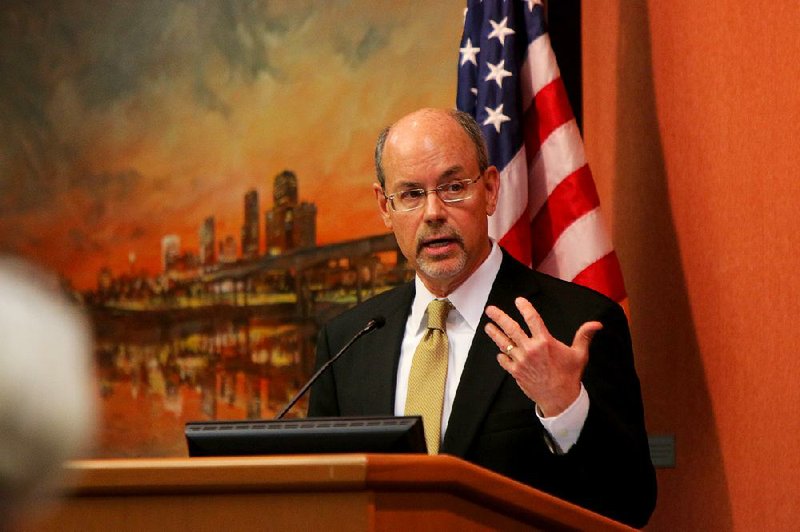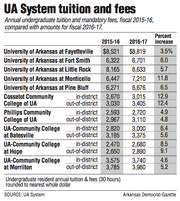NASHVILLE -- All of the University of Arkansas System's colleges and universities will either charge students new fees or increase existing ones in the coming school year to help pay for the campuses' share of a systemwide software project.
The aim is to get all of the 11 campuses in the system on the same software to handle student services information, financial data and human-resources matters. Each campus will be able to use the software independently, but the information also can be used at the system level, said Ann Kemp, the system's vice president for administration.
A committee is working on a "request for proposal" to solicit software-project information from companies. The cost of the software project won't be known until the companies submit their proposals.
In anticipation of paying that cost, the campuses are already gearing up to meet it. Four-year schools are directing a half-percentage point of their tuition increases to the project, and two-year schools are contributing $1 per credit hour.
The campus fees for the software project range from an increase of $1.42 per credit hour in the "network and data systems" fee at the University of Arkansas at Fayetteville to a new $5 per credit hour "technology fee" at the University of Arkansas Community College at Hope.
On Wednesday, UA System President Donald Bobbitt presented the tuition and fee recommendations to trustees. The board's Audit and Fiscal Responsibility Committee approved the proposed rates, which will go to the full board of trustees for a vote today. There was no indication that the board will reject the increases.
Like many other systems, all of the UA System's six universities and five colleges -- including the University of Arkansas for Medical Sciences in Little Rock -- are to charge more in tuition and fees starting July 1.
Last week, Arkansas Tech University in Russellville raised its tuition and fees by 7 percent for its in-state undergraduates, and Henderson State University in Arkadelphia bumped up its tuition and fees by about 4 percent.
Earlier this week, the University of Central Arkansas in Conway increased its tuition and fees by 4.25 percent for in-state undergraduates. Trustees for Southern Arkansas University in Magnolia are to vote on that campus's rates today, and the Arkansas State University System board is to follow suit Wednesday.
The uptick in tuition and fees is happening around the nation as states' higher-education funding either declines or remains the same. Higher-education leaders say their institutions have only two revenue streams: investments, which haven't been adequate, and tuition and fees.
In Arkansas, where state higher-education funding has been flat, campus and system leaders say they need to raise rates so they can maintain their programs and student services.
On Wednesday, Bobbitt revealed the UA System's priorities for the coming year and what challenges the chancellors face.
"If you go all the way back to 2008, the presumed start of the recession, and project it forward, you'll see that across the state ... funding for higher education has been up about on average a half percent every year," he said. "Meanwhile, the price index that is driven by the cost of higher education is up almost 15 percent over that same period of time. The only source we have to keep making progress is through tuition."
Bobbitt had asked that all of the campuses invest in student-success initiatives in part because state funding for higher education is likely to change from an enrollment-based model to an outcomes-based model.
"The reason why it's critically important at this point is that the state and federal government are both taking a look at new ways to fund higher education, which will reward and fund higher education for successes and not for starters," he said. "Specifically, it's an output model in which you will get to claim when they complete a class, program -- not when they start. We have about three to five, six years to turn this around."
Initiatives will use data analytics to identify students who need academic help, and then campus advisers and other support staff members can mold academic programs to help the individual students, he said.
Another reason for the tuition and fee increases is to raise money for building maintenance, he said. Collectively, the UA System has about $100 million in deferred maintenance that is considered critical to address and $1 billion in deferred maintenance that should be tackled at some point, he said. He added that those figures don't include work at UAMS.
He said UA faculty members are among the lowest-paid when compared with educators in the 16-state Southern Regional Education Board, and that the system needs to pay competitive salaries to retain quality faculty members.
"There's a variety of other costs and things that we're not doing that we need to do," Bobbitt said. "I think the appropriate measure of what our campuses have asked for is to take a look at the new funds that they anticipate they will receive through a tuition increase or through enhanced enrollment and what they have to work with to carry out the business of the campus."
UA System universities
All of the UA System's four-year universities are looking to bolster their institutional scholarships to help students, board documents show.
Students at the Fayetteville campus will face a 3.5 percent tuition and fee increase for the 2016-17 school year, which will raise the annual cost for those taking 30 credit hours over two semesters by nearly $300. Such student each will pay $8,819, up from $8,521.
The University of Arkansas at Fort Smith, which has seen an enrollment decline in recent years, is expecting its enrollment to level out, according to board documents. UAFS has reallocated some faculty members, putting more in high-demand fields and eliminating some in low-demand fields. It also has combined some staff positions and adjusted the duration of some positions, making them nine-month or 10½-month appointments, documents show.
UAFS is projecting $42.5 million for salaries, fringe benefits and faculty promotions. That includes UAFS bearing the full cost of the July 1 health plan increases, documents show.
At the University of Arkansas at Little Rock, in-state undergraduates can expect tuition and fee increases of 5.7 percent. UALR plans to raise its athletics fee from $18.75 to $20 per credit hour, which will add institutional full-ride scholarships.
The University of Arkansas at Monticello is adding two fees, both $10 per credit hour, to pay for deferred maintenance and student-success initiatives. Last year, the state said UAM did not reach the minimum score to receive state performance-based funds. Officials have attributed that, in part, to low retention rates, something UAM has been working to improve.
At the University of Arkansas at Pine Bluff, leaders are expecting higher enrollment to increase revenue by $2.2 million. As enrollment goes up, UAPB plans to put $175,000 into student-success initiatives.
It also plans to raise the "facility use" fee from $17 per credit hour to $22 per credit hour to help pay for deferred maintenance and to build a new dormitory.
UA System colleges
Among the UA System's two-year schools, Cossatot Community College plans a 12.9 percent increase in tuition and fees -- the highest percentage increase of the system's colleges. In-district students from Sevier, Howard and Little River counties can expect to pay $3.50 more in tuition -- $68.50 per credit hour.
The college also is adding a $3 per-credit-hour enterprise fee and a $5 per-credit-hour critical maintenance fee. The school, whose main campus is in De Queen, is budgeting $42,500 for critical maintenance and low-value equipment items, documents show.
At UA's Phillips Community College, leaders are expecting a slight increase in revenue, mostly because of an increase in tuition and fees. The college has instituted an early-retirement program as it reorganizes departments and positions.
It has hired an enrollment-management director to lead recruitment, retention and graduation efforts, documents show.
The UA Community College at Batesville is the only school in the UA System that doesn't plan to increase tuition. But, it plans to increase facility and technology fees by about 6.5 percent for in-state undergraduates, which will take in $237,000 more for the school.
Students will pay $2 more -- or $9 per credit hour -- for the facility fee and $4 more -- or $10 per credit hour -- for the technology fee.
The UA Community College at Hope is raising tuition rates by $1 per credit hour for in-district students and $2 for out-of-district, in-state undergraduates. Previously, an in-district student paid $63 per credit hour, and an out-of-district, in-state student paid $69 per credit hour. For the 2016-17 school year, an in-district student can expect to pay $64 per credit hour, and the out-of-state, in-district student can expect to pay $71 per credit hour.
At the UA Community College at Morrilton, leaders are adding a $5 per-credit-hour technology fee for the systemwide software program.
The Morrilton school also is looking to increase its scholarships for high school students who are taking college-level courses there, and use the money to replace its air-conditioning units.
At Wednesday's meeting, former U.S. Sen. David Pryor, a UA System board trustee, asked Bobbitt if there was any way to predict what tuition and fee rates will look like beyond this year and what the state-funding outlook is.
Bobbitt said he couldn't foresee what rates will be in coming years but he didn't expect state funding for higher education to increase in the near future.
"We have to find ways to make sure our institutions and the students we attract ... are successful," he said. "We have to find ways to do what we're doing now but with the same resources."
A Section on 05/26/2016

